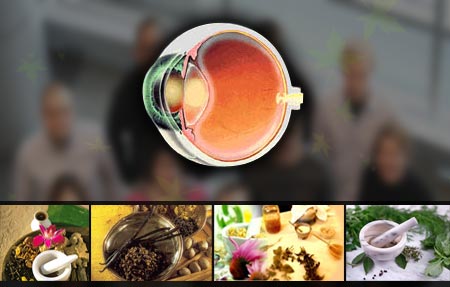
In Bhojaratnakar it is said that “not observing the advisable seasonal regimen, heat, exacerbation of grief, injury, excessive sexual intercourse, suppression of tears and straining the eyes, lead to vitiation of vayu and that leads to many diseases of the eyes.’’
Cataract known as timira or lin ganasha in ayurveda is one of the most common eye diseases in old age. The most common being is senile/old age cataract. It is an unavoidable disease of the old age. Most of us develop cataract by 50 years with varying degree. This obscures vision and leads to difficulties in focusing on near objects as years go by. However, only some people develop a greater degree of opacity and require surgical replacement of lens, if the affected cataract is a matured cataract.
Symptopms of Eye Cataract
The first sign to appear is the blurring of vision. Patients find it difficult to focus on they object and get double vision or spots or both. In the final stage there is a grayish white discoloration of the pupil. Cataract also brings about emotional stress and falls while on the road, bringing about fractures.
Causes of Eye Cataract
Cataract is almost always associated with defective vision. There are mainly four factors which result in loss of transparency of eye lens.
1. Stagnation of the fluid current in the lens due to decreased blood circulation.
2. Due to MANDAGNI,ie, decreased gastric fire, absorption of food is poor thereby malnourishing the whole of body including ocular lens which leads in poor functioning of the lens fibres.
3. Due to poor blood circulation and decreased natural resistance (decrease in macrophages and T-lymphocytes) there is deposition of various salts on lens, which increases pressure on the lens, thereby affecting vision by gradually destroying fibres and disintegrating the lens fibers, clouding the whole lens in the absence of appropriate measures.
4. Toxins in the blood stream due to a faulty lifestyle can greatly contribute to the formation of early cataract. The toxin matters of blood constantly search a weak spot for its shelter. The over straining of eyes by watching excess television, computers, reading books in dim lights and in faulty postures results in irritation of eyes thereby making it more weak.
Other less common causes of cataract are ocular injury, stress and strain, excessive alcohol intake, excessive intake of salts and sugars, gastrointestinal or gallbladder disturbances, diabetes, malnourishment, fatty acid intolerance, radiation, side effects of allopathic drugs, etc.
Naturopathic Treatment
It is helpful only at early stages when there are initial signs of cataract development. In advanced stages nothing can be done except for the surgical replacement of lens. A thorough course of cleansing the entire body of toxins is required to start with. This is done by taking enema for 3 days with castor oil errand oil, followed by an only-juice diet for 4 days. This will be citrus fruit juices which are high in vitamin C that help early repair of collagen tissues of the body. Citrus fruits like sweet lime, oranges can do.
Seasonal vegetables can be taken with soaked raisins, olive oil and lemon juice. Evening meals may consist of steamed vegetables such as spinach, fenugreek, drum sticks, cabbage, cauliflower, carrot, turnips and a few nuts or some fruits. Strictly avoid potatoes or white flour or any baked food. Use less salts and sugars. Avoid refined cereals, rice, puddings, pies coffee and tea. No pickle, sauces, condiments, or any other beverages should be used while taking treatment. Aniseed (saunf) is considered as an excellent remedy of cataract. The patient should take about six grams of aniseed everyday in the morning and evening. Equal quantities of aniseed and coriander powder mixed with brown sugar are also beneficial. This helps eyes to regain its vigor.
2 glasses of fresh carrot juice, one in the morning and one in the evening, is very beneficial as it has high amounts of vitamin A. Also, unprocessed honey can be used twice to thrice a day as eye drops for reliving stress from eyes. Epsom salt bath should be taken twice a week. Ocular exercises like rolling the eye in clock-wise and anticlock-wise directions, up and down, right and left should be done for 10 minutes in the morning and 10 minutes in the evening.
Mahatriphala ghrita is very useful in complete reversal of eye diseases like cataract but only if used in early stages of disease when the lens opacity has just begun to develop.
This ghrita (medicated ghee) is given twice a day in dose of 2 table spoons with warm water. Triphala water, in which all three myrobalans, harada, bahera and amla have been soaked overnight, should be used to wash the eyes at least three times a day.
Chandrodaya vati is rubbed in honey to prepare a paste which is applied to the eyes. This works as a mild irritant, thereby promoting increases blood circulation to eyes and lacrination(tears) in the eyes, hence nourishing ocular tissues.
Likewise if there is myopia Yashti Madhu is the drug of choice. Half teaspoon of this powder is given with 1/4 teaspoon of ghee and half teaspoon of honey twice a day on an empty stomach.
Asanas which have inverted postures help to reverse all ocular problems as it increases blood circulation to eyes. Sarvangasana, shirsasana are highly beneficial.
By – Dr. Hiren Parekh
